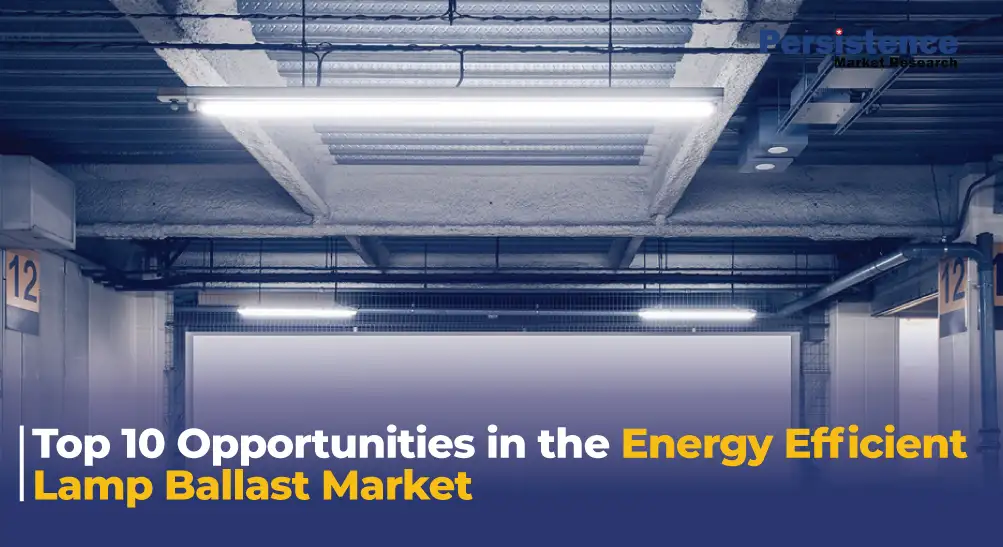- Blog
- Energy Efficient Lamp Ballast Market Overview
Top 10 Opportunities in the Energy Efficient Lamp Ballast Market
Published On : 16 Oct 2025
The energy efficient lamp ballast market is undergoing a significant transformation as technological advancements, evolving energy standards, and large-scale retrofitting programs reshape global lighting infrastructure. Once a low-margin component category, lamp ballasts now represent a strategic opportunity for innovation in energy management and lighting control systems. The following ten opportunities outline how this market is expanding and where the most substantial growth potential lies.

1. Expansion of Electronic Ballasts in Fluorescent Retrofits
Commercial and institutional buildings worldwide continue to operate with outdated magnetic ballasts and T8 or T12 fluorescent systems. Replacing them with electronic ballasts provides measurable improvements in efficiency, reducing energy consumption by up to 25%. The transition not only lowers operational costs but also enhances lamp life and overall system reliability. This retrofit wave remains a key source of demand, particularly in regions implementing stringent energy codes such as the United States and Europe.
2. Integration of LED Drivers as the New Ballast Category
As the lighting market shifts toward LEDs, traditional ballast functions are being absorbed by LED drivers. Manufacturers that adapt existing ballast technology into smart, dimmable, and high-efficiency LED driver systems are gaining a competitive edge. These next-generation drivers deliver consistent illumination, reduce flicker, and improve power factor, creating a bridge between legacy fluorescent fixtures and advanced LED systems.
3. Growth of Smart Ballasts with IoT Connectivity
Smart ballasts incorporating wireless communication, occupancy sensors, and control logic are transforming lighting from a static function to a data-driven networked system. These connected ballasts allow real-time monitoring, adaptive brightness, and integration with building management systems. Companies such as Signify and OSRAM have already introduced intelligent ballast systems that support dynamic lighting environments in commercial buildings and industrial facilities.
4. Increasing Role in Demand Response and Grid Flexibility
Energy efficient ballasts that support dimming or adaptive control can be integrated into demand-response programs to balance grid load during peak demand periods. Utilities and energy aggregators are exploring these lighting systems as flexible assets capable of contributing to grid stability. The ability to control large lighting networks in real time introduces an emerging revenue stream linked to energy market participation.
5. Development of Modular Retrofit Kits and Plug-and-Play Systems
Simplifying retrofit processes remains a major commercial opportunity. Modular kits that allow easy ballast or driver replacement without rewiring or fixture modification are driving faster adoption among small and medium enterprises. Plug-and-play systems reduce installation time, labor costs, and potential downtime, making them attractive for rapid building upgrades in offices, retail, and healthcare facilities.
6. Specialized Solutions for Harsh and Industrial Environments
Energy efficient lamp ballasts designed for extreme conditions such as high temperatures, humidity, or vibration are becoming essential in industrial, mining, and transportation sectors. These heavy-duty ballasts improve durability and performance under demanding conditions. Manufacturers focusing on such niche segments achieve product differentiation and secure long-term supply contracts with infrastructure and manufacturing clients.
7. Compliance with Energy and Safety Standards as a Market Driver
Evolving efficiency standards, including IEC, ENERGY STAR, and ISO certifications, continue to influence ballast design and purchasing decisions. Products that meet or exceed these standards benefit from preferential procurement, especially in public infrastructure projects and certified green buildings. Compliance demonstrates quality assurance and strengthens market positioning across regulated regions.
8. Emergence of Service-Based Lighting Models
The growing shift toward performance-based models is changing how lighting equipment is sold and maintained. Some manufacturers and service providers now offer long-term contracts covering installation, operation, and maintenance under fixed service fees. This trend creates recurring revenue opportunities while ensuring consistent energy savings over time. The ballast becomes part of a broader lighting service ecosystem rather than a standalone component.
9. Adoption of Sustainable and Circular Design Principles
Sustainability is becoming a defining theme in ballast manufacturing. Companies are increasingly designing products that can be disassembled, recycled, or reused. Circular design initiatives, such as take-back programs for end-of-life ballasts and use of recyclable components, align with global environmental targets. This practice also reduces waste while appealing to organizations pursuing ESG-aligned procurement strategies.
10. Integration of Data Analytics and Predictive Maintenance
Modern energy efficient ballasts are evolving into data-generating devices. Integrated sensors and connectivity features allow continuous performance tracking, enabling predictive maintenance and operational optimization. By analyzing usage data, manufacturers can improve reliability, while building operators gain insights into lighting performance and energy efficiency trends. This shift toward data-centric lighting systems positions ballasts as key contributors to intelligent building management.
Conclusion
The energy efficient lamp ballast market is transitioning from a component-driven business to a technology-enabled ecosystem focused on performance, connectivity, and sustainability. Innovation in electronic and smart ballasts, combined with the rapid replacement of legacy systems, continues to drive steady demand worldwide. As global lighting standards tighten and building automation accelerates, the market is expected to grow through integration with LED systems, demand-response mechanisms, and data-based services. Companies that emphasize reliability, energy optimization, and compliance are poised to lead this evolving sector.
Industry Report

Energy Efficient Lamps And Ballasts Market
195 Pages |16 Jul 2025
Format: PDF, Excel, PPT*
Request Report Sample
Your privacy is important to us; your data is secure
Contact Us
Latest Reports
-
In-Mold Coating Market by Product Type (Water-based, Solvent-based, Powder, Other), Substrate (Thermoplastics, Thermosetting), Industry (Electronics & Appliances, Automotive & Transport, Sanitary Products, Building & Construction, Other), and Regional Analysis for 2025 - 2032
-
Automotive Active Health Monitoring Systems Market by System Location (Driver’s Seat and Dashboard), by Component (Sensors, Software and Hardware), Application Outlook (Pulse Rate, Blood Sugar Level, Blood Pressure and Misc.), End-user (Passenger Car, LCV and HCV) and Regional Analysis for 2025 - 2032
-
Medical Oxygen Cylinders Market by Product (Fixed Medical Oxygen Cylinders and Portable Medical Oxygen Cylinders), by End-user (Hospitals, Specialty Clinics, Ambulatory Surgery Centers, and Home Care Settings and Others), and Regional Analysis from 2025 - 2032
-
Temporary Cardiac Pacing Wires and Leads Market by Product (Cardiac Pacing Wires and Cardiac Pacing Leads), by Application (Cardiothoracic Surgeries, Acute Myocardial Infarction, Bradycardia, Heart Blocks, Sick Sinus Syndrome, and Congestive heart failure (CHF)), Technique (Epicardial Pacing, Transvenous Pacing, and Transcutaneous Pacing), Age Group (Pediatric, and Adult), by End-user, and Regional Analysis from 2025 - 2032
-
Hospital Acquired Pneumonia Prevention Market by Product (Oral Care Kits, Toothbrush, Vaccines, Swab, Moisturizer, Mouth Wash, Suction Tools, and Others), End User (Hospitals, Rehabilitation Centers, Ambulatory Surgery Centers, Home Care Settings, and Others), and Regional Analysis from 2025 to 2032
